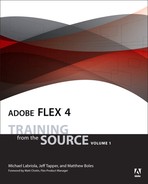Foreword
Ten years ago Macromedia coined the term rich Internet application, or RIA, to describe the modern web application: one where a significant amount of data and business logic live on a server or in the cloud, but where the computing power of the desktop is leveraged to provide a great user experience. Flex has been at the center of the RIA landscape since Macromedia introduced it in 2004 and subsequent releases came under the Adobe name in 2006, after Adobe’s acquisition of Macromedia. With the release of Flex 4, Adobe is bringing the power of the RIA to an even broader audience of developers. The book you have in your hand is a great first step in learning to use that power.
Adobe Flex comprises a number of elements. It has a declarative markup language called MXML to help you structure your application, and it uses ActionScript 3.0 (an implementation of ECMAScript) to add all the programming power you need. Your UI can be customized using the familiar CSS syntax. In addition to learning the languages that Flex uses (and when to use each), you’ll learn about the powerful component library and the best way to leverage it in your applications. Flex provides layout containers, form controls, formatters and validators, a rich text library, an effects and animation library, and much more to allow you to quickly build your user interface. And when Flex doesn’t provide something out of the box, you can easily build it yourself by extending what does exist.
Much of our time in Flex 4 was spent introducing the next generation of the Flex component framework called Spark. Building on top of Flex’s existing architecture, Spark provides a much more expressive mechanism for developers and designers to work together on the appearance of their Flex applications. Spark promotes thinking in terms of Model-View-Controller (MVC) and enables the functionality of components to be cleanly separated from their visual appearance and behavior. In addition to simply making Flex applications easier to develop and maintain, this separation also allows for better collaboration between designers and developers, who may not be able to work on the application using the same tools.
Of course it’s not enough to have a pretty interface; your application needs to be functional, and often that means manipulating data. You’ll find that Flex offers a variety of ways to connect to your backend data sources, from XML over HTTP, to SOAP web services, to an efficient remoting protocol called Action Message Format, or AMF, which is supported by every major backend technology. Flex also offers tight integration with Adobe LiveCycle Data Services, a powerful offering that makes it easy to manage large sets of data, especially when that data is shared among many users.
While every element of Flex can be coded by hand with your favorite text editor on top of the open source Flex SDK, Adobe Flash Builder 4 is a fantastic IDE built on top of Eclipse that can help build and test a lot of your functionality faster. And as part of Flex 4, Adobe is introducing a new tool, Adobe Flash Catalyst, which allows designers to easily collaborate with developers in creating great user experiences. Additionally, there are a number of third-party tools, libraries, and extensions (some written by your authors!) aimed at making you more productive in your development.
But it’s not enough to simply know about the pieces that make up a Flex application. You have to know how to use them well. Adobe Flex 4: Training from the Source draws from the expertise of its authors to present a number of lessons that will not only introduce you to the concepts of Flex, but also help you use best practices as you go. With this introduction you’ll find yourself quickly building applications that look better and do more than anything you’ve done before.
You know those applications that you see in the movies that seem so unrealistic? With the power of Flex 4 and its related tools, they may not be that far off! We at Adobe can’t wait to see what you build.
Matt Chotin
Senior Product Manager
Adobe Systems, Inc.
